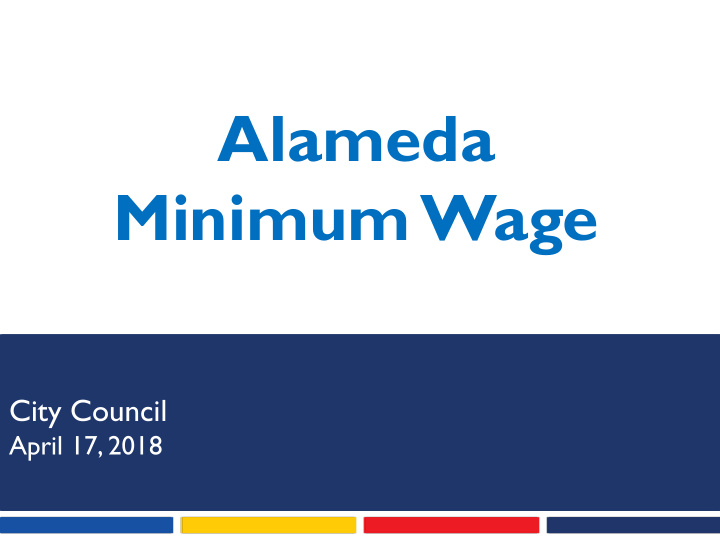



Alameda Minimum Wage Alameda Economic Development Strategic Plan City Council Task Force Meeting #4 April 17, 2018 October 30, 2017
California’s Minimum Wage Legislation adopted in April 2016 to reach statewide minimum wage of $15/hour by January 1, 2023 Minimum wage will increase by the rate of inflation starting in 2023 with a ceiling of 3.5 percent per year Delayed increase for businesses with 25 or less Average annual increase 7.4 to 8.06 percent over five to six years
California’s Minimum Wage (cont.) California's Minimum Wage $16.00 $15.00 $14.00 $13.00 $12.00 $11.00 $10.00 $9.00 Jan-17 Jan-18 Jan-19 Jan-20 Jan-21 Jan-22 Jan-23 25 employees or less 26 employees or more
City Council Referral On November 1, 2016, the City Council direct staff to: “Review enacting a minimum wage increase in Alameda” “Identify possible parameters” and “what other cities in California have done” Prepare discussion points for City Council direction
Bay Area Cities with more aggressive timetables to reach $15/hour Alameda County Other Bay Area Cities Berkeley Cupertino Emeryville Los Altos Oakland Milpitas San Leandro Mountain View Palo Alto Contra Costa County San Francisco Richmond San Jose El Cerrito San Mateo Santa Clara Sunnyvale
Comparison of East Bay Cities City Effective Date Current Minimum Wage Alameda (25 or less employees) $10.50 Alameda (more than 25 employees) $11.00 Berkeley 2014 $13.75 El Cerrito 2016 $13.60 Emeryville (55 or less employees) 2015 $14.00 Emeryville (more than 55 employees) 2015 $15.20 Oakland 2015 $13.23 Richmond 2016 $13.41 San Leandro 2017 $13.00
Parameters: Time to Implement Lengthy public engagement process Average 4.2 months time to implement ordinance Time to reach $15/hour (the “on - ramp”) ranged from two to seven years
Parameters: Business Size State of California (25 or fewer employees) Local Jurisdictions Emeryville (55 or fewer employees) City of Los Angeles (25 or fewer employees) Los Angeles County (25 or fewer employees) Malibu (25 or fewer employees) Pasadena (25 or fewer employees) Santa Monica (25 or fewer employees)
Parameters: Consideration of Other Benefits Examples of other business considerations: Slower phase-in for non-profit organizations (San Mateo) Crediting health benefits towards minimum wage (Richmond)
Parameters: Off-ramp Provisions Five Bay Area cities have provisions to pause minimum wage increases due to economic considerations (“off ramps”): Negative job growth • Decline in sales tax receipts • Determinations are made annually Off ramps do not apply once cities have reached $15/hour
Options for Council Consideration Three Options for Council Consideration 1) Conduct community outreach and return with a recommendation 2) Maintain the State’s minimum wage schedule 3) Direct staff to draft a minimum wage ordinance
Option 1: Conduct Community Outreach Objectives of community outreach: Present information on the effects of minimum • wage ordinances in other cities Solicit concerns with levels of support for a • minimum wage ordinance Return in late November or early December 2018 with a recommendation: • Provides staff with sufficient time to determine potential impact on the city’s budget
Option 1: Conduct Community Outreach (cont.) Community engagement to encompass: Local residents • Business associations • Businesses that tend to employ hourly workers • Local community organizations • • Labor unions Mayor’ Economic Development Advisory Panel • Recreation and Parks Commission •
Option 2: Maintain the State’s Minimum Wage Schedule Continue the Status Quo. No further action required. Reason: The gain to Alameda workers is determined not to be substantially greater than provided under State law
Option 3: Direct Staff to Draft an Ordinance Direct staff to draft an ordinance: More aggressive than the state’s timetable • Abbreviated public outreach process • Would need to be adopted September 4, 2018, if to • go into effect with four month lead-time on January 1, 2019
Option 3: Direct Staff to Draft an Ordinance (cont.) Considerations: Amend the City’s budget and fee schedule related to City programs with high levels of part-time employees Direct staff how to approach elements of a proposed ordinance, such as: Business size • Non-profit organizations • • Other benefits offered by employers
Financial Impacts: The City as an Employer An increase in minimum wage would significantly impact two departments: 87 percent of employees currently earning less than • $15/hour are with Recreation and Parks Department’s recreational programs • 5 percent of employees are with the Library Would require an increase in fees for service or a • greater General Fund contribution to maintain current level of services
Financial Impacts (cont.) The staff report does not have a complete estimate of the cost to the City for adopting an ordinance Staff will develop a full analysis if Council directs staff to move forward with developing an ordinance Additional costs may include: • Costs of existing contractors Monitoring and enforcement •
Recommendation Staff is prepared to move forward with any of the three options presented or any variations of the options Staff recommendation is the first option: Conduct community outreach • • Determine potential fiscal impacts Return with a recommendation for an ordinance •
Recommend
More recommend